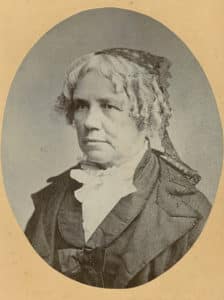by Amy Jenness

Suddenly , Maria Mitchell was catapulted into a new life that would provide opportunities not previously available. She worked for the government. She was invited into elite, male organizations. She travelled in Europe and America. She inspired women to become scientists. And, for the rest of her life she was regarded internationally as a celebrity.
In 1852, The New York Times ran a speech made to the British Parliament by John Lee, who had just lost to Benjamin Disraeli, in which he urged Disraeli to support women’s suffrage and named several distinguished women, including “Miss Mitchell the astronomer of New York.” The Times took offense at Lee’s geographical inaccuracy.
The allusion to “Miss Mitchell the astronomer,” is a gratifying national compliment; but the additional words” of New York,” are worthy the confused ideas of Englishmen, who make the double mistake of centralizing the whole of this country into one focus, and of locating that focus at New-York. In the same way Mr. Webster was introduced at a public dinner in London as “a distinguished member of the upper Senate of New York.” Such instances of glaring ignorance are too common.
Friend and confidant to influential scientists and writers, Maria’s life was one of firsts. Born in 1818 and one of 10 children, Maria Mitchell became the first female employee of the government in 1849 when the Nautical Almanac Office opened. She was hired to compute the positions of the planet Venus. During the mornings she calculated its orbit, in the afternoons she worked at the Atheneum, and in the evenings she searched the sky for comets. She never married and her financial independence and her accomplishments allowed her to travel.
When Vassar Female College opened in 1865 as the first school entirely for women, it hired Maria Mitchell as professor of astronomy. Initially educated by her father William Mitchell and then self-taught, Maria would teach a generation of women seeking a college degree in science. Her students went on to break barriers in American academia and earn the first science Ph.D. degrees for women in the United States.
And she was invited to join the male-dominated American Academy of Arts and Sciences in 1850 and the American Philosophical Society in 1869. Maria encouraged her students to be independent scientists with a healthy mistrust of authority. “We cannot accept anything as granted beyond the first mathematical formulae. Question everything else,” she told them. At the end of her life, despite her accomplishments, Maria was disappointed that working women were not compensated or treated the same as men. Maria and another female Vassar colleague took salary disputes to the administration, claiming they were paid less than half what male professors were paid. Their disputes were never resolved.
Born on an island dominated by the Quaker ideals of equality and a voice for all, Maria grew up knowing Nantucket-born feminist Lucretia Mott and later befriended other women’s rights activists, including Mott’s close friend Elizabeth Cady Stanton. In 1873 Mitchell had attended the first Women’s Congress, which was also attended by Susan B. Anthony, Lucy Stone, Dr. Elizabeth Blackwell, and Antoinette Brown Blackwell.
That year she co-founded the American Association for the Advancement of Women, served as its president in 1875 and later chaired its science committee. In 1876, at the fourth congress of the American Association for the Advancement of Women, Maria Mitchell presented a paper on “The Need of Women in Science.”
In her speech she said,
“Does anyone suppose that any woman in all the ages has had a fair chance to show what she could do in science? The laws of nature are not discovered by accidents; theories do not come by chance, even to the greatest minds; they are not born of the hurry and worry of daily toil; they are diligently sought, they are patiently waited for, they are received with cautious reserve, they are accepted with reverence and awe. And until able women have given their lives to investigation, it is idle to discuss the question of their capacity for original work.”
Maria Mitchell continued her political pursuits and taught at Vassar until 1888 when she left due to ill health. She died the next year in Lynn, Massachusetts. Even after her death, Maria Mitchell continued to break down gender barriers. In 1923 the Hall of Fame for Great Americans at New York University, which had posthumously inducted Maria in 1905, decided to abandon its policy of segregating the displays of its honorees by gender. The New York Times noted:
While under the consolidation plans, the women’s tablets in most cases will be moved over among the men. But Maria Mitchell will have the distinction of having the men come to her. Her tablet, and the bust which stands in the niche above, will remain where they are and will become the centre of the group of scientists which includes John James Audubon, Asa Gray, Louis Agaasiz, and Joseph Henry.
Amy Jenness is author of On This Day In Nantucket History.